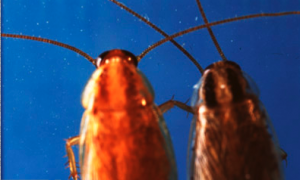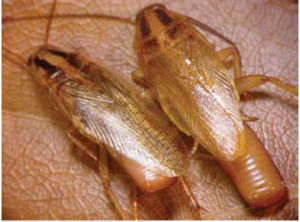Asian Cockroach is another member of the roach family which is fast becoming a major pest throughout the southern United States. This roach thrives in tropical and subtropical climates and was first discovered in Tampa Florida in 1986. Early control methods and general knowledge of this pest was slow in coming due in large part to the under estimation of this insect. Florida residents were inundated with this flying roach which seemed to break all conventional wisdom of then understood roach habits and professional exterminators had little answers. Since its discovery in Central Florida this roach has spread across the southeast to Texas and as far north as South Carolina. The asian roach is truly omnivorous eating plant material as well as meats. At least one known benefit of the roach is that it readily feeds on certain crop pest eggs and is a common predator of the bollworm.
Asian roaches are most prominent during the summer months and survive the colder temperatures mostly by burrowing into deep leaf litter. Even in warmer times it’s not uncommon to find thousands of asian roaches in all stages of life in just a moderate sized pile of leaves. It takes approximately 67 days for nymphs to reach adulthood and females can produce egg capsules that can carry up to 44 babies soon after they’ve matured.
How They Travel
Unlike the german roach, the asian is a very skilled flyer and actually is attracted to lights. The asian roach prefers to live outdoors but will survive inside for a time if the humidity is right or there is a source of moisture. Able to fly in open doors or crawl through small cracks or unfit screens this roach often invades at night attracted by porch lights or lights from inside. Nymphs do not fly but prefer to stay in organic litter feeding presumably on the decaying matter. The asian roach is not known to travel in freight or articles being moved across the country such as landscaping materials but this could be possible.
How Best To Identify Asian Roaches
The asian roach dilemma is that it looks almost exactly like the Hard To Tell, Isn't It.
Treatment And Elimination
Inside conventional indoor treatments work well for the asian roach with an emphasis around windows and doors where this pest will most likely first enter. The asian roach does not thrive inside so a full scale treatment with dusts, baits and sprays as you would need for german roaches is not always as necessary. Simple liquid residuals in cracks and crevices will do for interior infestations. Exterior treatments and or modifications are far more likely to produce the best results for asian roach reduction and if possible, elimination. Liquid insecticide barriers around lights, windows, doors and other entry points such as hose spigots, base of siding, cracks or other voids work well but are often short lived. Concentrates such as Demand CS or Suspend SC and Tempo are excellent choices for these areas but please read the labels for any limitations and safety recommendations.
Dusts are a longer term answer for voids where this pest may enter such as listed above. DE (diamataceous earth), boric acid, Delta dust or Drione are all long term options for voids but Delta is specifically formulated to withstand the most moisture and may be the best choice. Proper equipment is needed such as a bulb, billow or puff duster to avoid off target application and complete treatments of voids.

Asian Left, German Right-Look At Wing Length
Probably the quickest route to eliminating the asian roach is to eliminate the organic material they most inhabit. Removal of leaf piles or burning provides very fast results. Changing outdoor lighting to yellow bulbs is also helpful to deter them but not quite as effective for the asian roach as it is for other insects.




